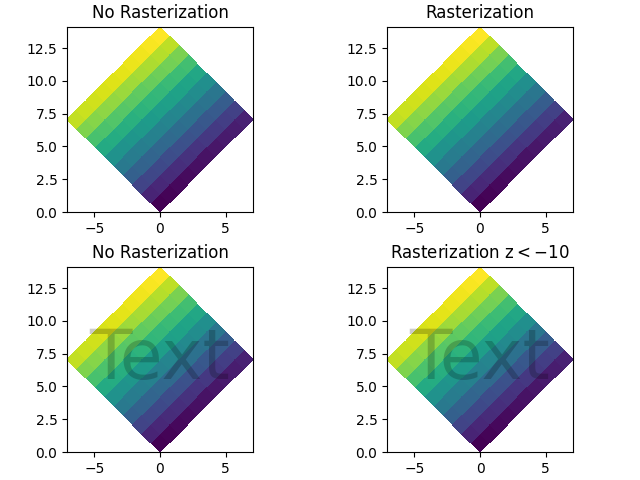Note
Go to the end to download the full example code
Rasterization for vector graphics#
Rasterization converts vector graphics into a raster image (pixels). It can speed up rendering and produce smaller files for large data sets, but comes at the cost of a fixed resolution.
Whether rasterization should be used can be specified per artist. This can be
useful to reduce the file size of large artists, while maintaining the
advantages of vector graphics for other artists such as the axes
and text. For instance a complicated pcolormesh or
contourf can be made significantly simpler by rasterizing.
Setting rasterization only affects vector backends such as PDF, SVG, or PS.
Rasterization is disabled by default. There are two ways to enable it, which can also be combined:
Set
set_rasterizedon individual artists, or use the keyword argument rasterized when creating the artist.Set
Axes.set_rasterization_zorderto rasterize all artists with a zorder less than the given value.
The storage size and the resolution of the rasterized artist is determined by
its physical size and the value of the dpi parameter passed to
savefig.
Note
The image of this example shown in the HTML documentation is not a vector graphic. Therefore, it cannot illustrate the rasterization effect. Please run this example locally and check the generated graphics files.
import matplotlib.pyplot as plt
import numpy as np
d = np.arange(100).reshape(10, 10) # the values to be color-mapped
x, y = np.meshgrid(np.arange(11), np.arange(11))
theta = 0.25*np.pi
xx = x*np.cos(theta) - y*np.sin(theta) # rotate x by -theta
yy = x*np.sin(theta) + y*np.cos(theta) # rotate y by -theta
fig, ((ax1, ax2), (ax3, ax4)) = plt.subplots(2, 2, layout="constrained")
# pcolormesh without rasterization
ax1.set_aspect(1)
ax1.pcolormesh(xx, yy, d)
ax1.set_title("No Rasterization")
# pcolormesh with rasterization; enabled by keyword argument
ax2.set_aspect(1)
ax2.set_title("Rasterization")
ax2.pcolormesh(xx, yy, d, rasterized=True)
# pcolormesh with an overlaid text without rasterization
ax3.set_aspect(1)
ax3.pcolormesh(xx, yy, d)
ax3.text(0.5, 0.5, "Text", alpha=0.2,
va="center", ha="center", size=50, transform=ax3.transAxes)
ax3.set_title("No Rasterization")
# pcolormesh with an overlaid text without rasterization; enabled by zorder.
# Setting the rasterization zorder threshold to 0 and a negative zorder on the
# pcolormesh rasterizes it. All artists have a non-negative zorder by default,
# so they (e.g. the text here) are not affected.
ax4.set_aspect(1)
m = ax4.pcolormesh(xx, yy, d, zorder=-10)
ax4.text(0.5, 0.5, "Text", alpha=0.2,
va="center", ha="center", size=50, transform=ax4.transAxes)
ax4.set_rasterization_zorder(0)
ax4.set_title("Rasterization z$<-10$")
# Save files in pdf and eps format
plt.savefig("test_rasterization.pdf", dpi=150)
plt.savefig("test_rasterization.eps", dpi=150)
if not plt.rcParams["text.usetex"]:
plt.savefig("test_rasterization.svg", dpi=150)
# svg backend currently ignores the dpi

The PostScript backend does not support transparency; partially transparent artists will be rendered opaque.
References
The use of the following functions, methods, classes and modules is shown in this example:
Total running time of the script: (0 minutes 1.043 seconds)